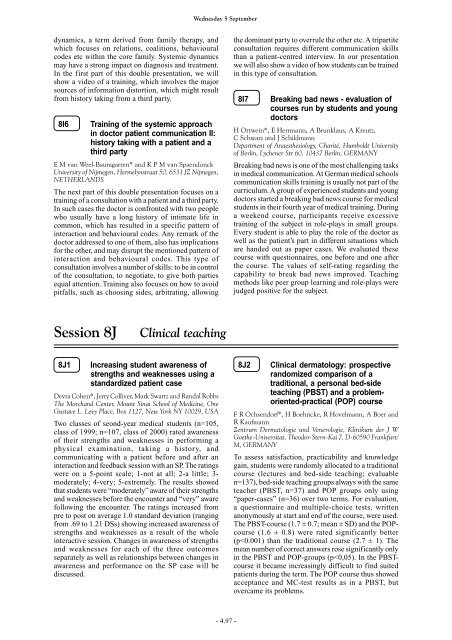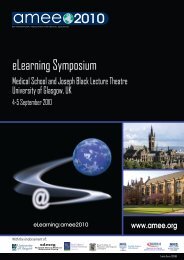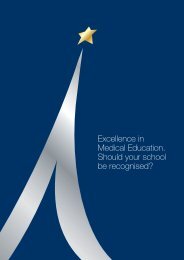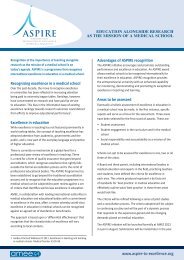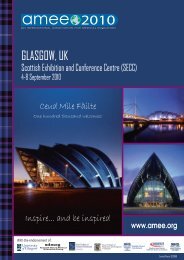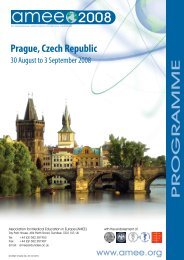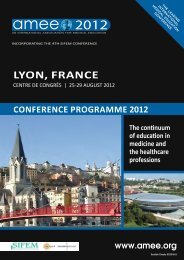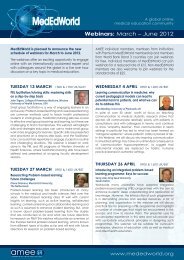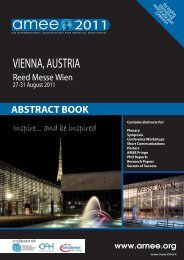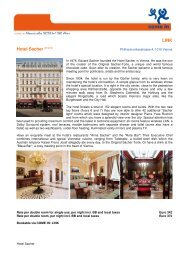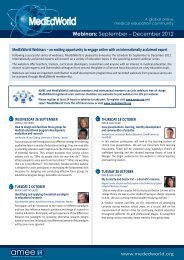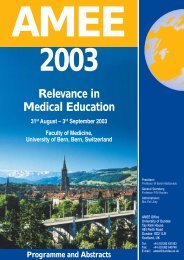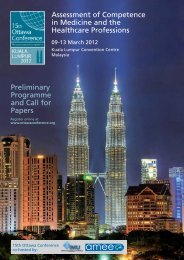AMEE Berlin 2002 Programme
AMEE Berlin 2002 Programme
AMEE Berlin 2002 Programme
Create successful ePaper yourself
Turn your PDF publications into a flip-book with our unique Google optimized e-Paper software.
dynamics, a term derived from family therapy, and<br />
which focuses on relations, coalitions, behavioural<br />
codes etc within the core family. Systemic dynamics<br />
may have a strong impact on diagnosis and treatment.<br />
In the first part of this double presentation, we will<br />
show a video of a training, which involves the major<br />
sources of information distortion, which might result<br />
from history taking from a third party.<br />
8I6 Training of the systemic approach<br />
in doctor patient communication II:<br />
history taking with a patient and a<br />
third party<br />
E M van Weel-Baumgarten* and K P M van Spaendonck<br />
University of Nijmegen, Hermelynstraat 50, 6531 JZ Nijmegen,<br />
NETHERLANDS<br />
The next part of this double presentation focuses on a<br />
training of a consultation with a patient and a third party.<br />
In such cases the doctor is confronted with two people<br />
who usually have a long history of intimate life in<br />
common, which has resulted in a specific pattern of<br />
interaction and behavioural codes. Any remark of the<br />
doctor addressed to one of them, also has implications<br />
for the other, and may disrupt the mentioned pattern of<br />
interaction and behavioural codes. This type of<br />
consultation involves a number of skills: to be in control<br />
of the consultation, to negotiate, to give both parties<br />
equal attention. Training also focuses on how to avoid<br />
pitfalls, such as choosing sides, arbitrating, allowing<br />
Session 8J Clinical teaching<br />
8J1 Increasing student awareness of<br />
strengths and weaknesses using a<br />
standardized patient case<br />
Devra Cohen*, Jerry Colliver, Mark Swartz and Randal Robbs<br />
The Morchand Center, Mount Sinai School of Medicine, One<br />
Gustave L. Levy Place, Box 1127, New York NY 10029, USA<br />
Two classes of seond-year medical students (n=105,<br />
class of 1999; n=107, class of 2000) rated awareness<br />
of their strengths and weaknesses in performing a<br />
physical examination, taking a history, and<br />
communicating with a patient before and after an<br />
interaction and feedback session with an SP. The ratings<br />
were on a 5-point scale; 1-not at all; 2-a little; 3moderately;<br />
4-very; 5-extremely. The results showed<br />
that students were “moderately” aware of their strengths<br />
and weaknesses before the encounter and “very” aware<br />
following the encounter. The ratings increased from<br />
pre to post on average 1.0 standard deviation (ranging<br />
from .69 to 1.21 DSs) showing increased awareness of<br />
strengths and weaknesses as a result of the whole<br />
interactive session. Changes in awareness of strengths<br />
and weaknesses for each of the three outcomes<br />
separately as well as relationships between changes in<br />
awareness and performance on the SP case will be<br />
discussed.<br />
Wednesday 5 September<br />
- 4.97 -<br />
the dominant party to overrule the other etc. A tripartite<br />
consultation requires different communication skills<br />
than a patient-centred interview. In our presentation<br />
we will also show a video of how students can be trained<br />
in this type of consultation.<br />
8I7 Breaking bad news - evaluation of<br />
courses run by students and young<br />
doctors<br />
H Ortwein*, E Herrmann, A Brunklaus, A Kreutz,<br />
C Schwarz and J Schildmann<br />
Department of Anaesthesiology, Charité, Humboldt University<br />
of <strong>Berlin</strong>, Lychener Str 60, 10437 <strong>Berlin</strong>, GERMANY<br />
Breaking bad news is one of the most challenging tasks<br />
in medical communication. At German medical schools<br />
communication skills training is usually not part of the<br />
curriculum. A group of experienced students and young<br />
doctors started a breaking bad news course for medical<br />
students in their fourth year of medical training. During<br />
a weekend course, participants receive excessive<br />
training of the subject in role-plays in small groups.<br />
Every student is able to play the role of the doctor as<br />
well as the patient’s part in different situations which<br />
are handed out as paper cases. We evaluated these<br />
course with questionnaires, one before and one after<br />
the course. The values of self-rating regarding the<br />
capability to break bad news improved. Teaching<br />
methods like peer group learning and role-plays were<br />
judged positive for the subject.<br />
8J2 Clinical dermatology: prospective<br />
randomized comparison of a<br />
traditional, a personal bed-side<br />
teaching (PBST) and a problemoriented-practical<br />
(POP) course<br />
F R Ochsendorf*, H Boehncke, R Hovelmann, A Boer and<br />
R Kaufmann<br />
Zentrum Dermatologie und Venerologie, Klinikum der J W<br />
Goethe-Universitat, Theodor-Stern-Kai 7, D-60590 Frankfurt/<br />
M, GERMANY<br />
To assess satisfaction, practicability and knowledge<br />
gain, students were randomly allocated to a traditional<br />
course (lectures and bed-side teaching; evaluable<br />
n=137), bed-side teaching groups always with the same<br />
teacher (PBST, n=37) and POP groups only using<br />
“paper-cases” (n=36) over two terms. For evaluation,<br />
a questionnaire and multiple-choice tests, written<br />
anonymously at start and end of the course, were used.<br />
The PBST-course (1.7 ± 0.7; mean ± SD) and the POPcourse<br />
(1.6 ± 0.8) were rated significantly better<br />
(p


